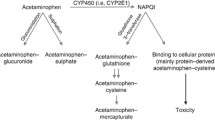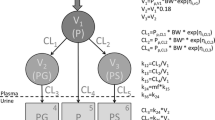Summary
There is little information about enteral drug absorption during development compared to that about drug distribution, metabolism and excretion. Therefore, the bioavailability, i.e. the amount and rate of absorption of various drugs (sulfonamides, phenobarbital, digoxin, β-methyldigoxin) and test substances (D(+)-xylose, L(+)-arabinose) was investigated in 580 children using pharmacokinetic methods. The amounts of the drugs absorbed, determined by Dost's law of corresponding areas, showed no age dependence. But the rate of absorption, ka, calculated from the concentration time curves using a digital approximation procedure (RIP), is low at the time of birth and reaches adult values after the neonatal period. This phenomenon is identical for all of the substances tested. A prolonged gastric emptying time in the neonate does not seem to be responsible for the delayed absorption since the lagtime is not related to age. Stimulation of intestinal motility with metoclopramide increases the absorption rates, both in neonates and older children, but the age dependent differences remain. Using various dosages of L(+)-arabinose the parameters of the saturation kinetics could be determined. In neonates Vmax values are significantly lower than in older children. Similarly, the affinity constant\(\mathop K\limits^ \star\) indicates a decreased capacity of enteral absorption in neonates compared with older children. Bioavailability data from adults cannot be accepted without further investigation since the rate of enteral drug absorption depends on age.
Similar content being viewed by others
References
Batt ER, Schachter D (1969) Developmental pattern of some intestinal transport mechanisms in newborn rats and mice. Am J Physiol 216: 1064–1068
Beyreiss K (1971) Resorption von 3-o-Methylglukose, D-Xylose und L-Arabinose. Untersuchungen bei stoffwechselgesunden Neugeborenen und Säuglingen. Pädiatr Grenzgeb 10: 151–166
Bratton AC, Marshall EK (1939) A new coupling component for sulfanil-amide determination. J Biol Chem 128, 537–550
Calingaert A, Zorzoli A (1965) The influence of age on 6-deoxy-D-glucose accumulation by mouse intestine. J Gerontol 20: 211–214
Caspary WF (1975) Resorption von Kohlenhydraten und Proteinen im Dünndarm unter normalen und krankhaften Bedingungen. Georg Thieme, Stuttgart
Dietschy JM, Sallee VL, Wilson FA (1971) Unstirred water layers and absorption across the intestinal mucosa. Gastroenterology 61: 932–934
Done AK (1966) Perinatal pharmacology. Annu Rev Pharmacol 6: 189–208
Dost FH (1968) Grundlagen der Pharmakokinetik. Georg Thieme, Stuttgart
Fordtran JS, Clodi PH, Soergel KH, Ingelfinger FJ (1962) Sugar absorption tests, with special reference to 3-o-Methyl-d-glucose and D-xylose. Ann Intern Med 57: 883–891
Gladtke E (1964) Mikrolitermethoden in der klinischen Chemie. II. Praktischer Teil. Ärztl Lab 10: 47–53
Gladtke E, Heimann G (1975) The rate of development of elimination functions in kidney and liver of young infants. In: Morselli P, Garattini P, Sereni F (eds) Basic and therapeutic aspects of perinatal pharmacology. Raven Press, New York, pp 393–403
von Hattingberg HM, Brockmeier D, Kreuter G (1977) A rotating interative procedure (RIP) for estimation hybrid constants in multi-compartment analysis on desk computers. Eur J Clin Pharmacol 11: 381–388
Heimann G (1980) Age dependence on gastrointestinal absorption in children. Symposion: 25 Years of Pharmacokinetics, 10.–11. Nov 1978 Köln. Gustav Fischer, Stuttgart
Heimann G (1978) Altersabhängigkeit der enteralen Absorption im Kindesalter. Habilitationsschrift Universität Köln
Heimann G, Gladtke E (1977) Pharmacokinetics of phenobarbital in childhood. Eur J Clin Pharmacol 12: 305–310
Holdsworth G, Wilson TH (1965) The development of active sugar and amino acid transport in the yolk sac. J Physiol (Lond) 183: 63–64
Kübler W (1970) Pharmakokinetische Methoden zur Ermittlung der enteralen Resorption. Z Kinderheilkd 108: 187–196
Levy G (1968) Kinetics and implication of dissolution rate limited gastrointestinal absorption of drugs. In: Proc 3. Intern Pharmacological Meeting, Vol. 7: Physico-chemical aspects of drug actions. Pergamon Press, Oxford New York
Mehnert H, Summa JD, Förster H (1964) Untersuchungen zum Xylitolstoffwechsel bei gesunden, leberkranken und diabetischen Personen. Klin Wochenschr 42: 382–387
Mirkin BL (1972) Symposium on developmental pharmacology. Fed Proc 31: 43–80
Morselli PL (ed) (1977) Drug disposition during development. Spectrum Publications, New York
Overton J (1965) Fine structure of the free cell surface in developing mouse intestinal mucosa. J Exp Zool 159: 195–201
Parsons RL, Hossack GA, Paddock GM (1975) The absorption of antibiotics in adult patients with coeliac disease. J Antimicrob Chemother 1: 39–50
Parsons RL (1977) Drug absorption in gastrointestinal disease with particular reference to malabsorption syndromes. Clin Pharmacokinet 2: 45–60
Read NW, Barber DC, Levin RJ, Holdsworth CD (1977) Unstirred layer and kinetics of electrogenic glucose absorption in the human jejunum in situ. Gut 18: 865–876
Ritschel WA (1973) Angewandte Biopharmazie. Wissenschaftliche Verlagsgesellschaft mbH, Stuttgart
Roe JH, Rice EW (1948) A photometric method for the determination of free pentoses in animal tissues. J. Biol. Chem. 173: 507–512
Smith CA, Nelson NM (eds) (1976) The physiology of the newborn infant. Charles Thomas, Springfield IL
Wagner JS, Pernarowski M (eds) (1971) Biopharmaceutics and relevant pharmacokinetics. Drug Intelligence Publications, Hamilton, IL
Weber WW, Cohen SN (1975) Aging effects and drugs in man. In: Gillette JR, Mitchell JR (eds) Concepts in biochemical pharmacology. Springer, Berlin Heidelberg New York, pp 213–233
Wilson FA, Sallee VL, Dietschy JM (1971) Unstirred water layers in intestine: Rate determinant of fatty acid absorption from micellar solutions. Science 174: 1031–1033
Wyngaarden JB, Segal S, Foley JB (1957) Physiological disposition and metabolic fate of infused pentoses in man. J Clin Invest 36: 1395–1407
Yaffe SJ, Juchau MR (1974) Perinatal pharmacology. Annu Rev Pharmacol 14: 219–238
Author information
Authors and Affiliations
Additional information
Supported by the Deutsche Forschungsgemeinschaft, grants Gl 82/1–3 and He 749/2
Rights and permissions
About this article
Cite this article
Heimann, G. Enteral absorption and bioavailability in children in relation to age. Eur J Clin Pharmacol 18, 43–50 (1980). https://doi.org/10.1007/BF00561477
Issue Date:
DOI: https://doi.org/10.1007/BF00561477




